
 Top Ausflugsziel 2024
Top Ausflugsziel 2024
Dieses Ausflugsziel für Familien gehört zu den besten Ausflugszielen 2024 laut dem familienausflug.info Award.
A maximum of 10 Excursion destinations can be selected for comparison. Please first remove existing Excursion destinations from the comparison.
Show comparison closePeriod
Description Destination
Germany's only zoological and botanical garden is home to around 11,000 animals of almost 1,200 species as well as 8,500 plant species and varieties on 30 hectares in the middle of Stuttgart in a historic park with Moorish architecture from the 19th century.
-
Age of children:0 to 1 years1 to 2 years2 to 4 years4 to 6 years6 to 10 yearsover 10 yearsYoung people
-
Destination is:a place worth seeing a playground a zooa place worth seeinga playgrounda zoo
-
Main topic:MovementDiscoverLearnPlayAnimals
- restaurant
- Price level: moderate
-
weather:Fair weatherRainy weatherChangeableCloudy
- Children's birthday parties
-
stroller:mostly suitablemostly suitable
-
dogs: not specified
- all properties (55)
Contact
Send unresolved inquiryphone: +49 711... show +49 711 / 54 02 0
Homepage: www.wilhelma.de/
reviews 3
Zu jeder Jahreszeit einen Besuch wertContinue reading...
Silke S.
to the evaluation overviewNearby attractions
PremiumPremium excursion destinations nearby are primarily displayed here.
-
 Erlebnispark Tripsdrill
Erlebnispark Tripsdrill
The TOP excursion destination in Cleebronn
Cleebronn 28.1 km -
 Kloster und Schloss Bebenhausen
Kloster und Schloss Bebenhausen
A trip tip for families in Tübingen
Tübingen 29.2 km -
 Freilichtmuseum Beuren
Freilichtmuseum Beuren
The excursion destination in Beuren
Beuren 29.5 km -
 Stadtmuseum Hornmoldhaus
Stadtmuseum Hornmoldhaus
A family trip to Bietigheim-Bissingen
Bietigheim-Bissingen 18.3 km -
 Blühendes Barock Ludwigsburg mit Märchengarten
Blühendes Barock Ludwigsburg mit Märchengarten
Unser Ausflugstipp in Ludwigsburg
Ludwigsburg 10.6 km -
 Schillers Geburtshaus
Schillers Geburtshaus
It is a place worth seeing in Marbach am Neckar
Marbach am Neckar 15.7 km
Properties of this Destination entry
-
Age of children:
0 to 1 years1 to 2 years2 to 4 years4 to 6 years6 to 10 yearsover 10 yearsYoung people
-
weather:
Fair weatherRainy weatherChangeableCloudy
-
Winter excursion destination - even in bad weather
-
stroller:
mostly suitable
- dogs
- Minimum age: no limit
-
barrier-free - Seasonal opening hours: open all year
- Information on opening hours: The Wilhelma opens every day of the year at 8:15 a.m. Closing times vary depending on the month between 4:30 p.m. and 8:00 p.m. For more information, visit www.wilhelma.de
-
Pre-registration required -
School trip - Video about the destination
-
 family cherries app
family cherries app
- Price level: moderate
- Comparison price for 3-year-olds: for free
- Comparison price for 8-year-olds: 8 Euro/day
- Comparison price for adults: 19 Euro/day
- Pricing: In addition to the standard rate for adults and seniors, day tickets also have reduced rates for students (18 to 28 years old) and children/young people (6 to 17 years old). There are also family tickets. Children under 6 can visit for free. Annual tickets are heavily discounted and pay for themselves after the fourth visit in twelve months.
- Discount code for online booking
-
Main topic:
MovementDiscoverLearnPlayAnimals
- Number of existing animal species: 1200
-
Length of time:
half day
- Children's birthday parties
-
childcare -
Highlights at the destination:
-

Wilhelma - Zoologisch-Botanischer Garten Stuttgart Highlights at the destination Varied park tour

Varied park tour
The recommended route is 5 kilometers long and takes you past the most important sights of the Wilhelma. The approximately 60 stations include the most striking representatives of rare animal species, exotic plants, listed buildings and the most beautiful viewpoints.
-
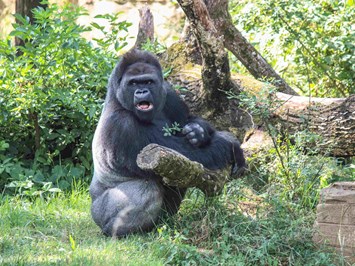
Wilhelma - Zoologisch-Botanischer Garten Stuttgart Highlights at the destination Great variety of monkeys
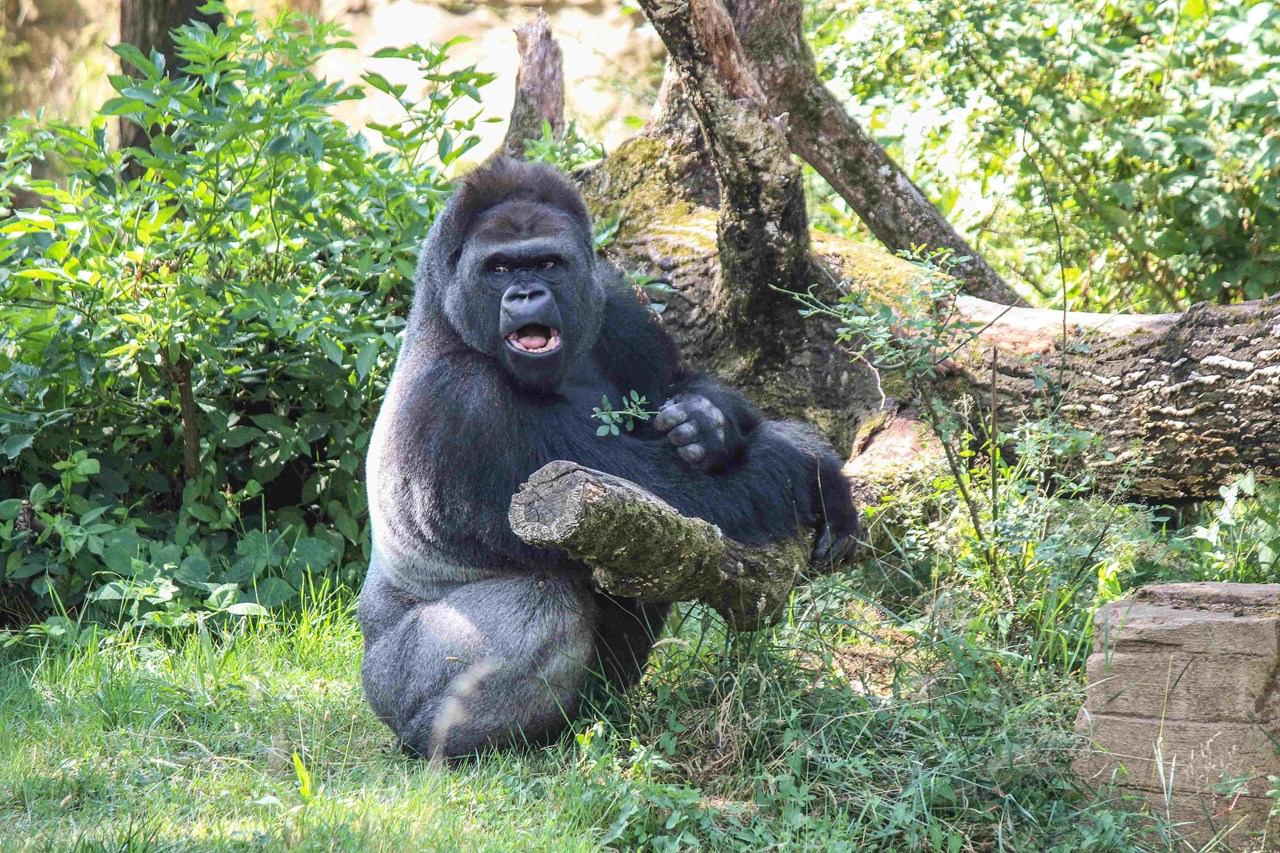
Great variety of monkeys
The Wilhelma exhibits 16 species of monkeys spread throughout the park: from the largest, the gorillas, to the smallest monkeys in the world, the pygmy marmosets. Gorillas, bonobos and orangutans live in the modern enclosure for great apes, which opened in 2013. The gorilla and bonobo clans in the Wilhelma are among the largest breeding groups in the world.
-
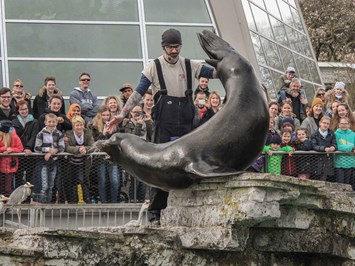
Wilhelma - Zoologisch-Botanischer Garten Stuttgart Highlights at the destination Commented feeding shows
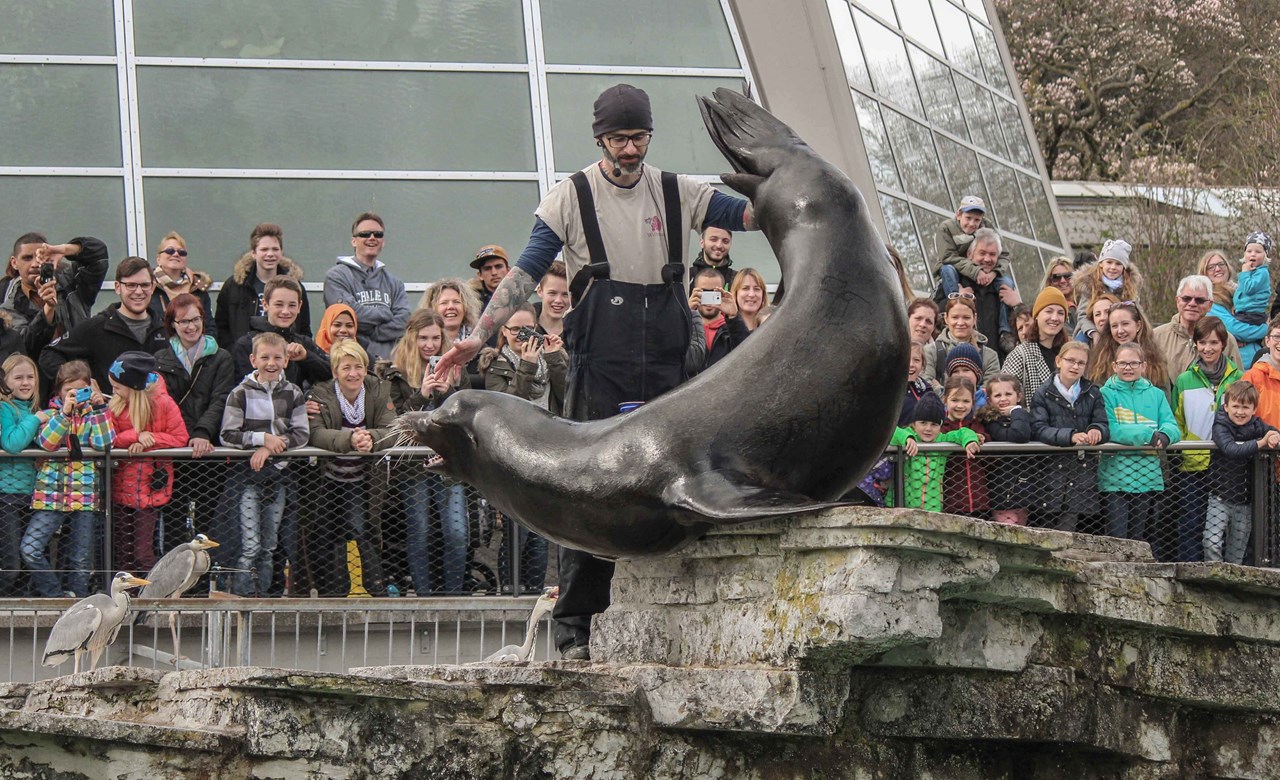
Commented feeding shows
There are feeding shows for selected animal species, some of which are also commented on. The feedings of the California sea lions, gorillas, African penguins and birds of prey are particularly popular, as is the jumping crocodile (only on Mondays).
-
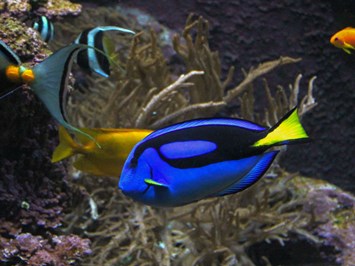
Wilhelma - Zoologisch-Botanischer Garten Stuttgart Highlights at the destination Aquarium and terrarium

Aquarium and terrarium
The aquarium and terrarium building is the site of the greatest biodiversity with around 500 species of fish, 90 species of reptiles and 160 species of amphibians and invertebrates. 71 aquariums as well as six climate landscapes and five shore pools show all types of aquatic worlds from rivers to coasts and reefs to the deep sea. The largest crocodile in Germany lives in the Australia Hall. Frederick is over 4.30 meters long and weighs around 520 kilos.
-

Wilhelma - Zoologisch-Botanischer Garten Stuttgart Highlights at the destination Tropical greenhouses
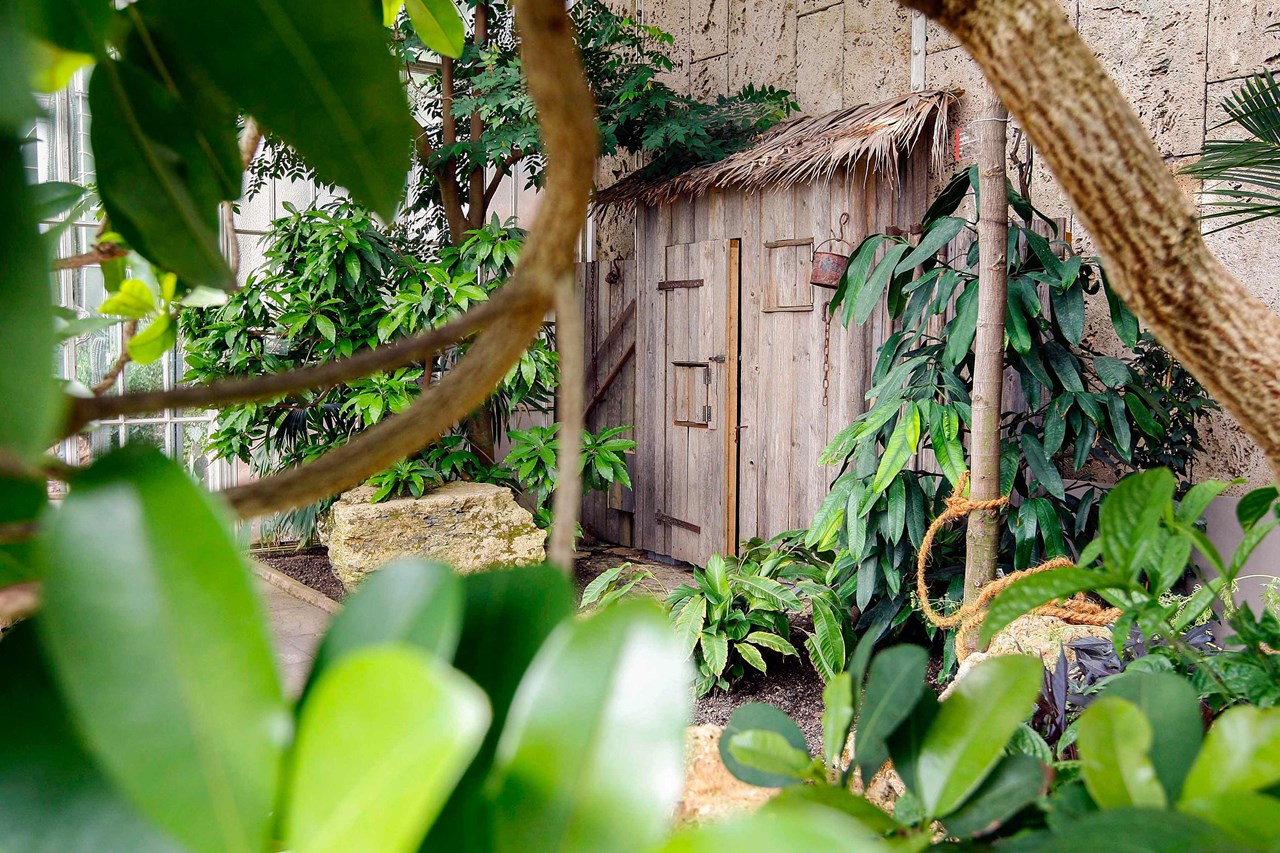
Tropical greenhouses
As a botanical garden, the Wilhelma has a number of valuable collections of exotic plants. The orchid collection is one of the largest and most important in Germany. But the camellias, azaleas, cacti and tropical crops also attract many visitors. The Amazon House with its rainforest biotope is also a special place for plant lovers.
-
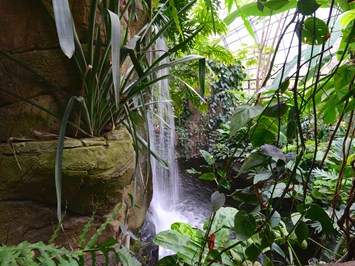
Wilhelma - Zoologisch-Botanischer Garten Stuttgart Highlights at the destination Amazon House

Amazon House
The Amazon House is like a small rainforest in South America. Mammals, birds, reptiles, fish and amphibians live there in a natural environment. Many of them roam freely in the house, which is always 26-27 degrees and has a humidity of 80 degrees. A jungle path leads the little and big explorers past a waterfall through the biotope.
-

Wilhelma - Zoologisch-Botanischer Garten Stuttgart Highlights at the destination Historic park
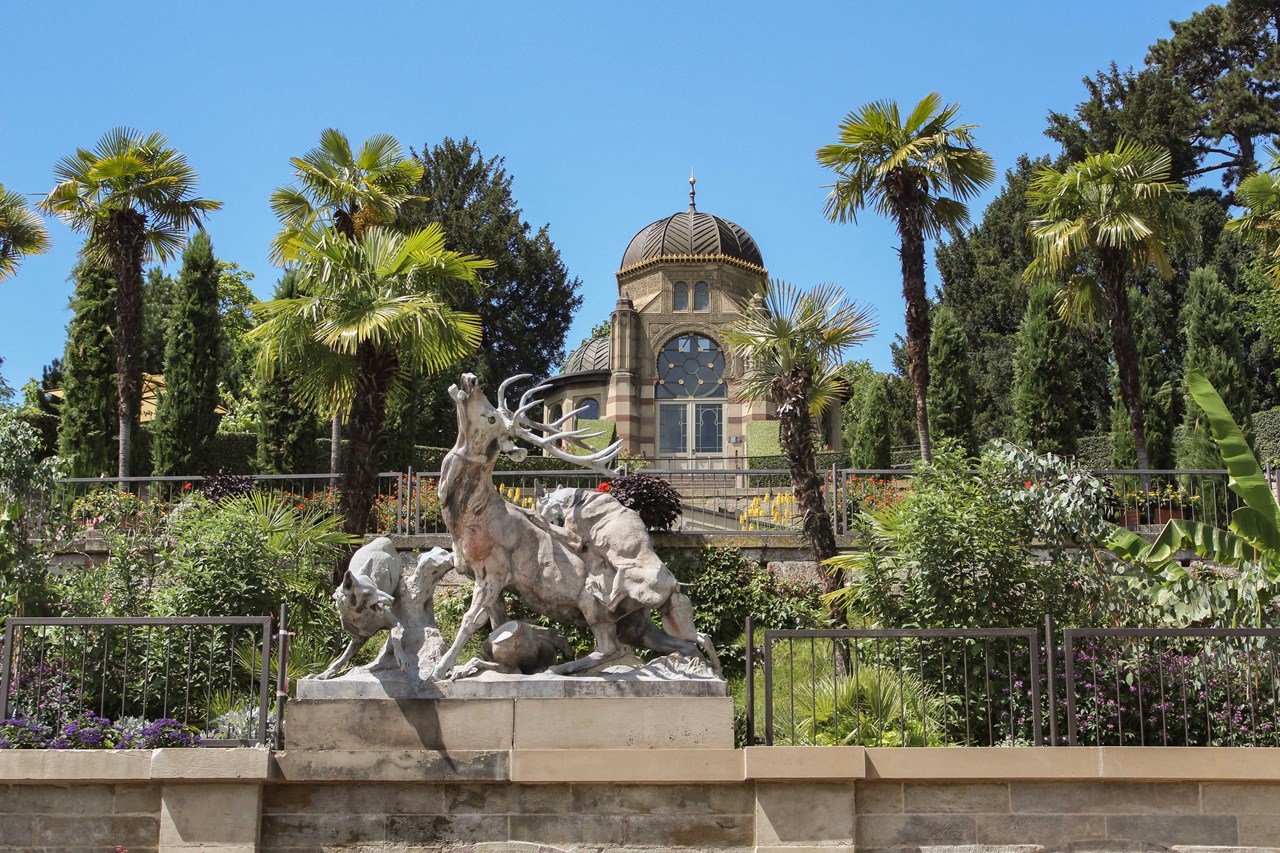
Historic park
The Wilhelma cannot be compared to other zoos because a king had it built as a pleasure garden with buildings in the Moorish style. They look like something out of 1001 Nights and provide an extraordinary backdrop for the exotic plants that were planted at the behest of Wilhelm I of Württemberg: including the largest magnolia grove north of the Alps and a small forest of sequoias. In total, there are around 160 tree species.
-
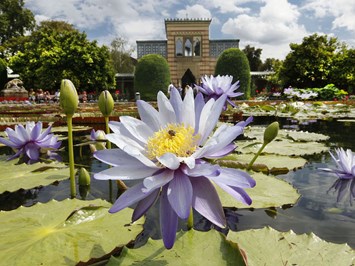
Wilhelma - Zoologisch-Botanischer Garten Stuttgart Highlights at the destination Moorish Garden
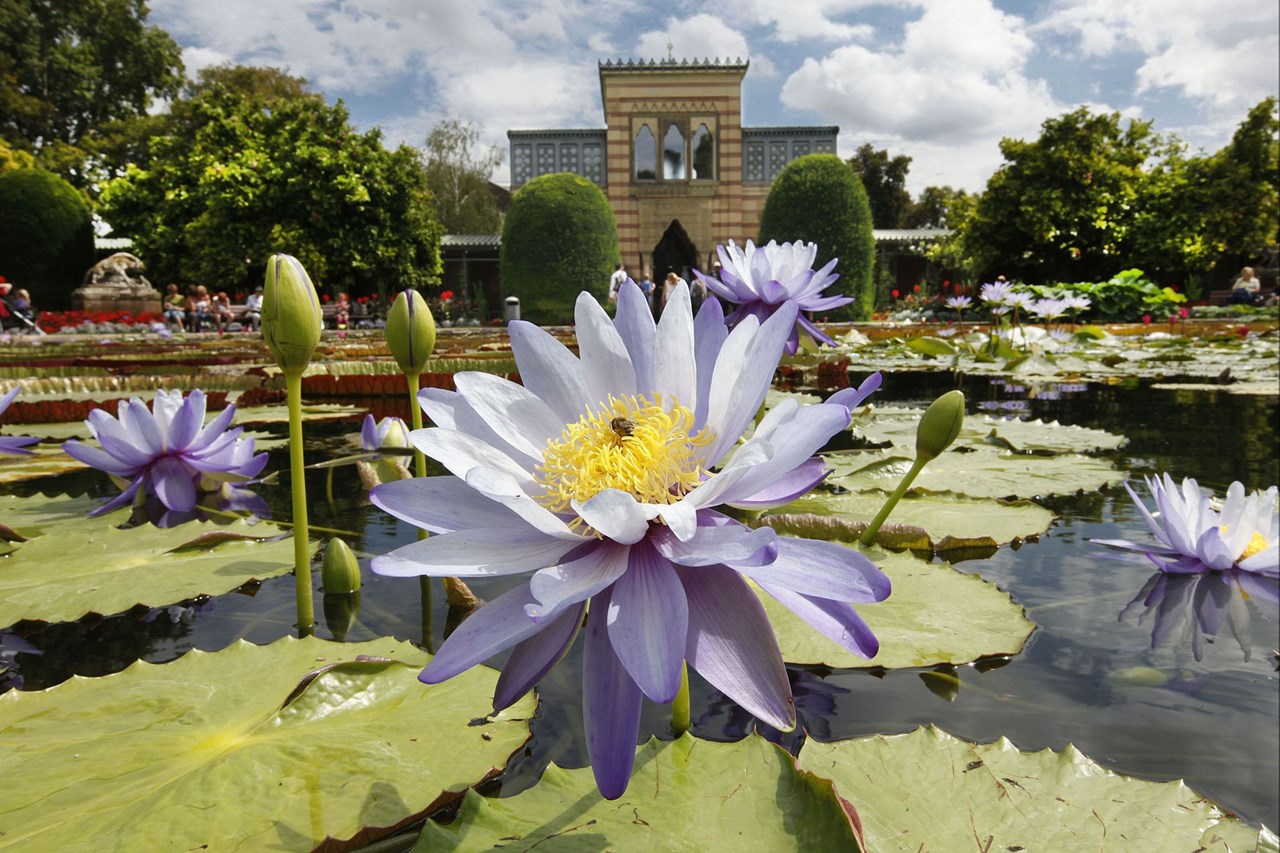
Moorish Garden
The heart of the Wilhelma is the Moorish Garden: a unique building ensemble of playful oriental architecture. The Moorish country house and the Moorish ballroom are connected by a walkway. In this oval, the large basin for tropical water lilies is a crowd puller.
-
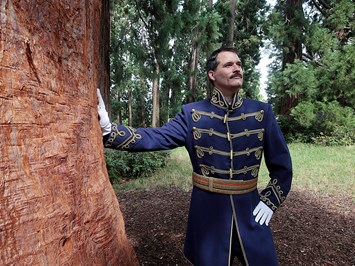
Wilhelma - Zoologisch-Botanischer Garten Stuttgart Highlights at the destination Sequoia Forest
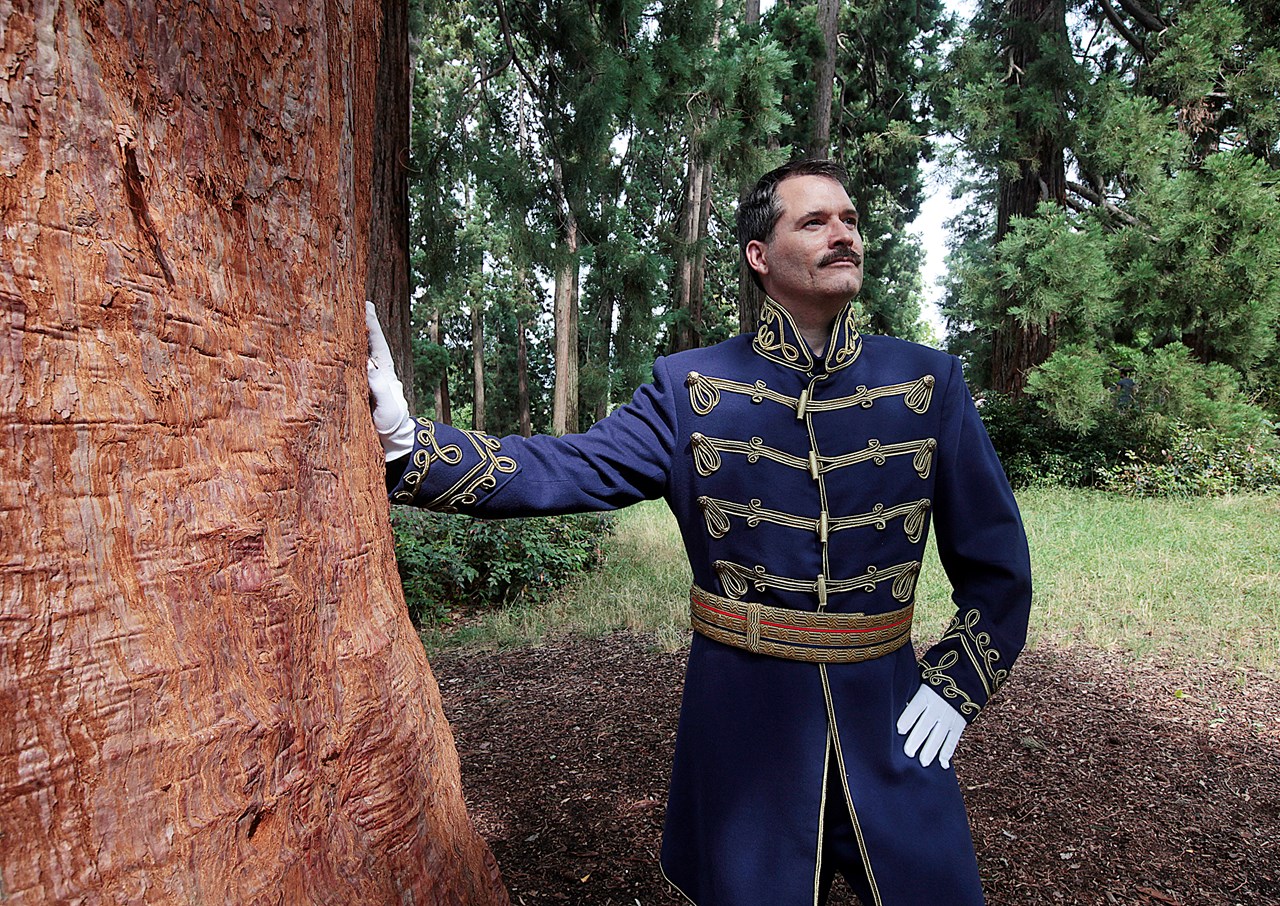
Sequoia Forest
More than 150 years ago, King Wilhelm I of Württemberg had seeds from the legendary giant sequoias sent to him from Canada. The monarch received so much seed that he had 200 of these giant trees planted in his kingdom between Lake Constance and the Odenwald. 35 of the giant sequoias grow as a small forest on a hill in the Wilhelma. As a place of peace, it is a counterpoint to the often bustling life in the rest of the park.
-

Wilhelma - Zoologisch-Botanischer Garten Stuttgart Highlights at the destination Show farm

Show farm
At the upper end of the Wilhelma Park is the demonstration farm. It displays rare domestic breeds of farm animals, such as Swabian-Halle pigs, Hinterwälder cattle and Skudden. There are also unusual farm animals from other countries, such as the huge Poitou donkeys from France and the woolly Kune-Kune pigs from New Zealand. In the petting zoo, African dwarf goats and Cameroon sheep are looking for companionship.
-
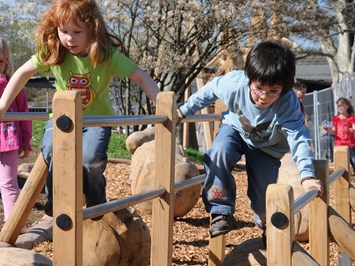
Wilhelma - Zoologisch-Botanischer Garten Stuttgart Highlights at the destination Children's gymnastics world

Children's gymnastics world
In cooperation with the Baden-Württemberg Children's Gymnastics Foundation, an exercise course with eleven stations has been created throughout the site. It encourages the children to imitate the movements of the animals that they can see near the exercise stations: for example, hopping like kangaroos, swinging like monkeys, running like rheas. There is also an accompanying booklet with additional information and a stamp sheet so that the children can see which part of the course they have already completed.
-

Wilhelma - Zoologisch-Botanischer Garten Stuttgart Highlights at the destination Wild weekends
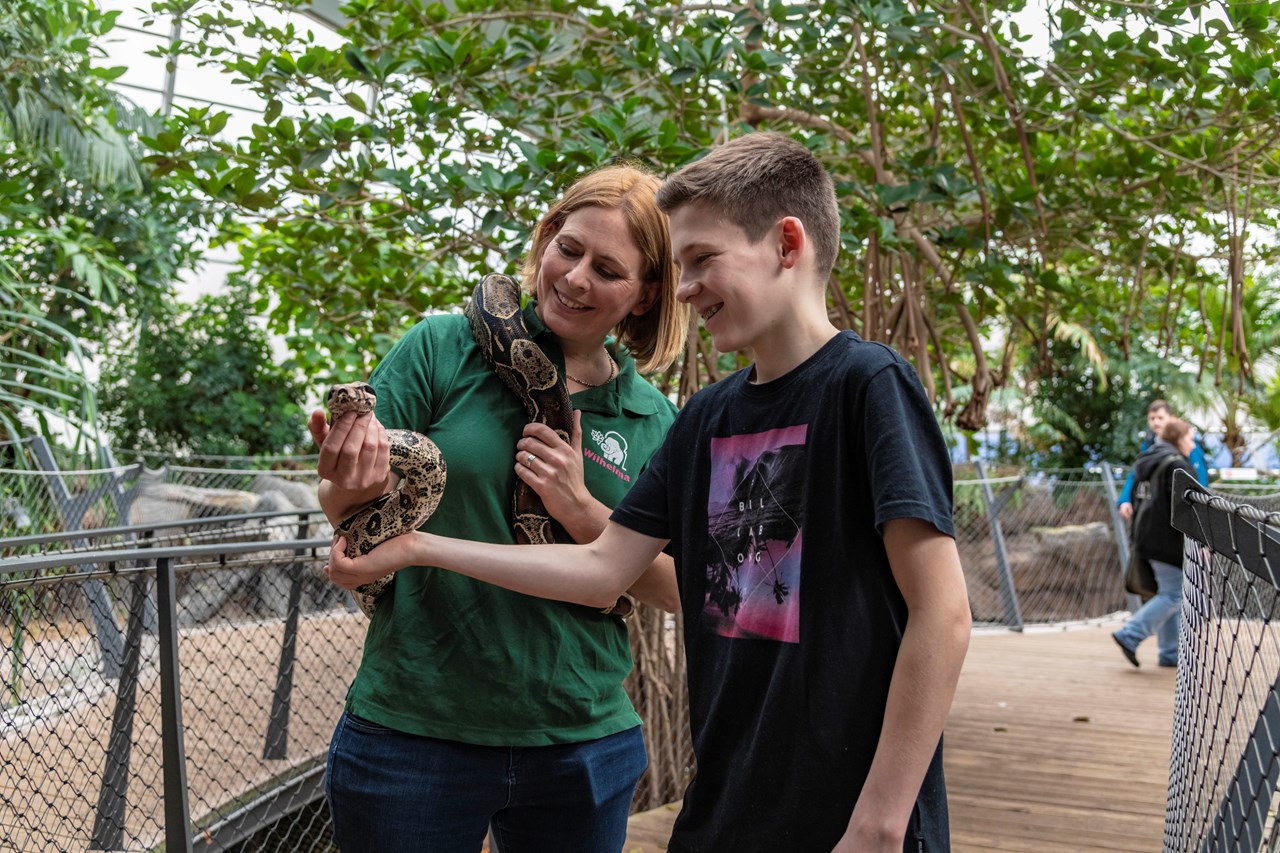
Wild weekends
The Wilhelma School and its teaching team offer theme days almost every weekend from March to October. The activities on animals, plants and nature conservation are aimed at children and adults alike. In the building opposite the vulture aviary there is a lot of visual material from the zoo and botanical garden. There is a flat fee for participating in activities, but participation itself is free.
-
- restaurant
- snack
- Supply option: on site
-
Daily opening hours supply / restaurant:
Monday Tuesday Wednesday Thursday Friday Saturday Sunday public holidays Open all day Open all day Open all day Open all day Open all day Open all day Open all day Open all day - WC
- Changing table
- public transportation: on site
-
reachable with:
automobileTrainbusBicycleShip
- Parking
- Number of parking spaces: 800
Directions
Access to the car park via Neckartalstraße (B10); stop "Wilhelma" of the U14 tram line in front of the main entrance; details at www.wilhelma.de
address
- Street: Wilhelma 13
- Postal code: 70376
- City: Stuttgart
- Federal State: Baden-Württemberg
- country: Germany
- Bad Cannstatt
- Latitude : 48.804140
- Longitude : 9.208030
Nearby attractions
PremiumPremium excursion destinations nearby are primarily displayed here.
-
 Erlebnishöhe Wald-Michelbach
Erlebnishöhe Wald-Michelbach
Save 20% on tickets in the online shop, with code: 2Fbruih
Wald-Michelbach 89.5 km -
 JUFA Hotels
JUFA Hotels
Happy Familienurlaub together
Nördlingen 94.2 km -
 Museum Ravensburger
Museum Ravensburger
Discover the Ravensburger Museum in a playful way
Ravensburg 117.9 km -
 JUFA Hotels
JUFA Hotels
Happy family vacation together
Lenzkirch-Saig 126.3 km -
 Insel Mainau
Insel Mainau
Mainau Island - Lots of nature experiences, fun and variety
Konstanz 122.3 km -
 JUFA Hotels
JUFA Hotels
Happy family vacation together
Meersburg 123.6 km
Destination photos
Upload photos now (as a visitor)
Rosapelikane leben auf dem Langen See vor der historischen Damaszenerhalle in der Wilhelma.

Das Brüderpaar Kajal und Shapur gehört zu den extrem seltenen Asiatischen Löwen, von denen es nur noch rund 400 auf der Welt gibt.

Auf ihrer Afrika-Anlage hält die Wilhelma Netzgiraffen und hat schon wiederholt Nachwuchs von den "hohen Tieren" hervorgebracht.

Die Gruppe der Westlichen Flachlandgorillas in der Wilhelma ist eine der größten und erfolgreichsten Zuchtgruppen für die bedrohte Menschenaffen-Art.

Blaue Pfauen leben frei im Zoologisch-Botanischen Garten. Ein prachtvolles Exemplar schlägt hier ein Rad vor der ebenfalls sehenswerten Fassade des Maurischen Landhauses.

Mit wechselnden Pflanzenschauen lockt die Wilhelma in ihre historische Gewächshäuser. Hier betrachtet ein Besucherpaar die Farbpracht der Azaleen. Die Kamelienblüte macht im Frühjahr immer den Auftakt. Später sind die Fuchsien an der Reihe.

Im Wintergarten sind saisonal Pflanzensammlungen zu sehen, die eher wegen ihrer Früchte interessant sind. Hier betrachtet eine Gärtnerin betrachtet Zitronatzitronen der Zitrusschau. Sehr gefragt sind auch die Chilipflanzen mit ihren scharfen Früchten.

Der größte Magnolienblüte nördlich der Alpen blüht im Maurischen Garten zwischen Mitte März und Mitte April. Jedes Jahr strömen Naturfreunde aus nah und fern in die historische Kulisse, um sich das Farbspektakel anzuschauen.

Das Leistenkrokodil Tong ist bekannt dafür, dass es bei der Fütterung (immer montags) senkrecht aus dem Wasser springt, um sich ein Hühnchen aus der Hand des Pflegers zu schnappen.

Friedliches Miteinander in der Schmetterlingshalle: Flugfuchs und Bananenfalter schlecken gemeinsam an demselben Fruchtspieß.

Die Brillenpinguine stammen aus Südafrika und fühlen sich deshalb im gemäßigten Klima auch in Stuttgart wohl.

Bei den Fenneks wechseln sich Neugier und Scheu ab. Hier spitzt ein Wüstenfuchs im Giraffenhaus die Ohren, um eine Geräuschquelle zu orten.





Destination photo gallery
1 / 17

Rosapelikane leben auf dem Langen See vor der historischen Damaszenerhalle in der Wilhelma.
2 / 17

Das Brüderpaar Kajal und Shapur gehört zu den extrem seltenen Asiatischen Löwen, von denen es nur noch rund 400 auf der Welt gibt.
3 / 17

Auf ihrer Afrika-Anlage hält die Wilhelma Netzgiraffen und hat schon wiederholt Nachwuchs von den "hohen Tieren" hervorgebracht.
4 / 17

Die Gruppe der Westlichen Flachlandgorillas in der Wilhelma ist eine der größten und erfolgreichsten Zuchtgruppen für die bedrohte Menschenaffen-Art.
5 / 17

Blaue Pfauen leben frei im Zoologisch-Botanischen Garten. Ein prachtvolles Exemplar schlägt hier ein Rad vor der ebenfalls sehenswerten Fassade des Maurischen Landhauses.
6 / 17

Mit wechselnden Pflanzenschauen lockt die Wilhelma in ihre historische Gewächshäuser. Hier betrachtet ein Besucherpaar die Farbpracht der Azaleen. Die Kamelienblüte macht im Frühjahr immer den Auftakt. Später sind die Fuchsien an der Reihe.
7 / 17

Im Wintergarten sind saisonal Pflanzensammlungen zu sehen, die eher wegen ihrer Früchte interessant sind. Hier betrachtet eine Gärtnerin betrachtet Zitronatzitronen der Zitrusschau. Sehr gefragt sind auch die Chilipflanzen mit ihren scharfen Früchten.
8 / 17

Der größte Magnolienblüte nördlich der Alpen blüht im Maurischen Garten zwischen Mitte März und Mitte April. Jedes Jahr strömen Naturfreunde aus nah und fern in die historische Kulisse, um sich das Farbspektakel anzuschauen.
9 / 17

Das Leistenkrokodil Tong ist bekannt dafür, dass es bei der Fütterung (immer montags) senkrecht aus dem Wasser springt, um sich ein Hühnchen aus der Hand des Pflegers zu schnappen.
10 / 17

Friedliches Miteinander in der Schmetterlingshalle: Flugfuchs und Bananenfalter schlecken gemeinsam an demselben Fruchtspieß.
11 / 17

Die Brillenpinguine stammen aus Südafrika und fühlen sich deshalb im gemäßigten Klima auch in Stuttgart wohl.
12 / 17

Bei den Fenneks wechseln sich Neugier und Scheu ab. Hier spitzt ein Wüstenfuchs im Giraffenhaus die Ohren, um eine Geräuschquelle zu orten.
13 / 17

14 / 17

15 / 17

16 / 17

17 / 17

Nearby attractions
PremiumPremium excursion destinations nearby are primarily displayed here.
-
 Erlebnispark Tripsdrill
Erlebnispark Tripsdrill
The TOP excursion destination in Cleebronn
Cleebronn 28.1 km -
 Kloster und Schloss Bebenhausen
Kloster und Schloss Bebenhausen
A trip tip for families in Tübingen
Tübingen 29.2 km -
 Freilichtmuseum Beuren
Freilichtmuseum Beuren
The excursion destination in Beuren
Beuren 29.5 km -
 Stadtmuseum Hornmoldhaus
Stadtmuseum Hornmoldhaus
A family trip to Bietigheim-Bissingen
Bietigheim-Bissingen 18.3 km -
 Blühendes Barock Ludwigsburg mit Märchengarten
Blühendes Barock Ludwigsburg mit Märchengarten
Unser Ausflugstipp in Ludwigsburg
Ludwigsburg 10.6 km -
 Schillers Geburtshaus
Schillers Geburtshaus
It is a place worth seeing in Marbach am Neckar
Marbach am Neckar 15.7 km
Summary
| Overall impression | 4,8 |
|---|---|
| Entertainment factor | 4,5 |
| Learning factor | 4,5 |
| Natural factor | 5,0 |
| Movement factor | 5,0 |
| Fun factor | 5,0 |
suitable for |
|
| stroller | 5,0 |
| Children from 0 to 1 years | 5,0 |
| Children from 1 to 2 years | 5,0 |
| Children from 3 to 4 years | 5,0 |
| Children from 4 to 6 years | 5,0 |
| Children from 6 to 10 years | 5,0 |
| Children over 10 years | 5,0 |
| Young people | 4,5 |
| School groups | 5,0 |
suitable for |
|
| sunshine | 4,5 |
| Rain | 4,5 |
| wind | 4,5 |
| Snow | 4,0 |
| heat | 4,0 |
| cold | 5,0 |
| changing weather | 3,0 |
| Cloud cover | 4,5 |
Destination reviews 3
4,5 / 5
32932 reviews
via: Google
Overall impression
Zu jeder Jahreszeit einen Besuch wert
Wir kommen sehr oft hierher und entdecken immer wieder was neues und haben spannende Tierbeobachtungen. Bei schlechtem Wetter geht man einfach in die zahlreichen Häuser und die vielen abwechslungsreichen Spielplätze sorgen für ausreichend Bewegung.
Silke S. visited Wilhelma - Zoologisch-Botanischer Garten Stuttgart in Dezember 2021 .
Overall impression
Stuttgart Wilhelma
An der frischen Luft und viel bewegen optimaler Ausflug für jeder Alter. Viele Tiere kennenlernen, anschauen Fütterung den Robben,Schmetterlingenparadies.Es wird nicht langweilig.
Julia H. visited Wilhelma - Zoologisch-Botanischer Garten Stuttgart in Juli 2021 .
Popular Ausflugsziele
PremiumPremium Ausflugsziele with the best ratings are primarily displayed here.
-
 Älteste Fachwerkhäuserzeile Deutschlands
Älteste Fachwerkhäuserzeile Deutschlands
The excursion destination in Esslingen am Neckar
Esslingen am Neckar 1 ref. 10.1 km -
 Museum St. Dionys - Mittelalterliches Ausgrabungsmuseum mit Krypta
Museum St. Dionys - Mittelalterliches Ausgrabungsmuseum mit Krypta
It is a museum in Esslingen
Esslingen 1 ref. 10.0 km -
 Weinprobe bei den Weingärtnern Esslingen
Weinprobe bei den Weingärtnern Esslingen
It is a place worth seeing in Esslingen am Neckar
Esslingen am Neckar 2 ref. 9.9 km -
 Seeschloss Monrepos
Seeschloss Monrepos
Unser Tipp für Familien in Ludwigsburg
Ludwigsburg 1 ref. 12.2 km -
 Burgruine Hohenneuffen
Burgruine Hohenneuffen
The excursion destination in Neuffen
Neuffen 1 ref. 30.4 km -
 Schulmuseum Nordwürttemberg
Schulmuseum Nordwürttemberg
A destination for families in Kornwestheim
Kornwestheim 1 ref. 7.2 km
Contact
-
address: Wilhelma 13 70376 Stuttgart Germany
- phone: +49 711... show +49 711 / 54 02 0
- fax: +49 711 / 54 02 222
- To the card
- For directions
- Homepage: www.wilhelma.de/
opening hours
opening hours:| Monday | Tuesday | Wednesday | Thursday | Friday | Saturday | Sunday | public holidays |
|---|---|---|---|---|---|---|---|
| Open all day | Open all day | Open all day | Open all day | Open all day | Open all day | Open all day | Open all day |
Nearby attractions
PremiumPremium excursion destinations nearby are primarily displayed here.
-
 Erlebnispark Tripsdrill
Erlebnispark Tripsdrill
The TOP excursion destination in Cleebronn
Cleebronn 28.1 km -
 Kloster und Schloss Bebenhausen
Kloster und Schloss Bebenhausen
A trip tip for families in Tübingen
Tübingen 29.2 km -
 Freilichtmuseum Beuren
Freilichtmuseum Beuren
The excursion destination in Beuren
Beuren 29.5 km -
 Stadtmuseum Hornmoldhaus
Stadtmuseum Hornmoldhaus
A family trip to Bietigheim-Bissingen
Bietigheim-Bissingen 18.3 km -
 Blühendes Barock Ludwigsburg mit Märchengarten
Blühendes Barock Ludwigsburg mit Märchengarten
Unser Ausflugstipp in Ludwigsburg
Ludwigsburg 10.6 km -
 Schillers Geburtshaus
Schillers Geburtshaus
It is a place worth seeing in Marbach am Neckar
Marbach am Neckar 15.7 km
All information about Destination Wilhelma - Zoologisch-Botanischer Garten Stuttgart is without guarantee
Public questions and answers about Wilhelma - Zoologisch-Botanischer Garten Stuttgart
Here you will find general questions and answers about the excursion destination entry. Ask a question if you have a public, general concern that might also be of interest to other visitors.
Click here to ask an individual question to the destination entry .
-
Was kostet eun 14tägiger Urlaub ab den 12 August
Siegfried T. asksUnfortunately there is still no answer to this question.
Split:

.png)






)



.png)